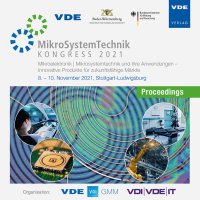Characterization of Reactive Multilayer Systems deposited on LTCC featuring different surface morphologies
Konferenz: MikroSystemTechnik Kongress 2021 - Kongress
08.11.2021 - 10.11.2021 in Stuttgart-Ludwigsburg, Deutschland
Tagungsband: MikroSystemTechnik Kongress 2021
Seiten: 5Sprache: EnglischTyp: PDF
Autoren:
Schulz, Alexander; Bartsch, Heike; Gutzeit, Nam; Mueller, Jens (Technische Universität Ilmenau (TU Ilmenau), Institute of Micro- and Nanotechnologies MacroNano®, Electronics Technology Group, Department of Electrical Engineering and Information Technology, Ilmenau, Germany)
Matthes, Sebastian; Schaaf, Peter (Group of Materials for Electrical Engineering and Electronics, Department of Electrical Engineering and Information Technology, TU Ilmenau, Germany)
Glaser, Marcus; Bergmann, Jean Pierre (Production Technology Group, Department of Mechanical Engineering, TU Ilmenau, Germany)
Ruh, Andreas; Wiese, Steffen (Universität des Saarlandes, Stiftungsprofessur für Mikrointegration und Zuverlässigkeit, Systems Engineering, Faculty of Natural Sciences and Technology, Saarbrücken, Germany)
Inhalt:
This paper presents the characterization of Al-Ni reactive multilayer systems (RMS) sputtered on LTCC substrates featuring different surface morphologies. All samples were able to ignite, followed by self-propagating exothermic reaction along the LTCC substrate surfaces which were simultaneously monitored using high velocity pyrometer and camera measurements. The adhesion of the ignited RMS was improved on LTCC substrates having surface roughness more than about 600 nm. A reduced influence of the substrate roughness on the measured temperatures was detected for these samples as well as measurements of their reaction velocities clarify a higher impact of different surface roughness. The promising results suggest that the reaction properties and the wave propagating directions can be controlled during reactive bonding or soldering of several applications in the field of electronic packaging by manipulating the substrate morphologies, e.g. using laser ablation on bonding areas.


